
Trumpeter 1/350 USS Hornet
|
KIT # |
|
|
PRICE: |
$100.00 + retail |
|
DECALS: |
one ship |
|
REVIEWER: |
|
|
NOTES: |
Gold Medal Models etched brass set used |

|
HISTORY |
For an excellent history of the seventh US ship named HORNET- see the reference section below. In short, one of three Yorktown class carriers, Hornet was the ship that carried Doolittleís Raiders to Tokyo in April 1942, was in the thick of the Midway battle a few months later, and eventually met her end in late October 1942 at the Battle of the Santa Cruz Islands.
|
THE KIT |
Putting aside the recent Trumpeter aircraft issues, from a ship modelerís perspective, we are happy as a pig in slop that anyone is releasing 1/350 plastic ship subjects. And to be honest, besides this modelís bow/ hull shape distortions (apparently the hull shape is not close to accurate)- the rest of what you get for your $100 is quite good.
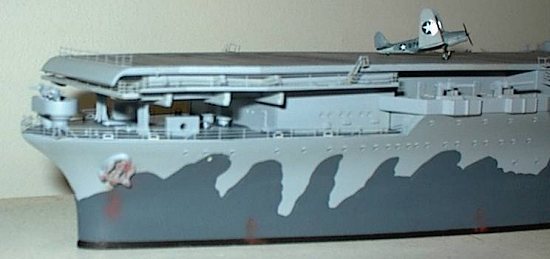 This is a big kit at just about 30 inches in length. A
massive one-piece upper hull greets you with the lower hull as an option for
non-waterline builders. The flight deck is molded in three pieces. Detail
overall is very well done with almost no flash to deal with and a crispness
that is admirable. At first study, the kit looks well engineered. I guess
the folks who work on the ships at Trumpeter are a bit more polished than the
airplane people!
This is a big kit at just about 30 inches in length. A
massive one-piece upper hull greets you with the lower hull as an option for
non-waterline builders. The flight deck is molded in three pieces. Detail
overall is very well done with almost no flash to deal with and a crispness
that is admirable. At first study, the kit looks well engineered. I guess
the folks who work on the ships at Trumpeter are a bit more polished than the
airplane people!
Honestly, to me Trumpeter has been a hit or miss affairóbut, if you keep in mind that the company has only been releasing kits for about 3 years- you have to be impressed that they have reached this degree already. Their 1/500 scale Nimitz carriers were toys and left me weary about the Hornet. No worries as this kit is wonderful to look at in the box and to build. I anxiously awaited my Gold Medal Models set to be etched and when it arrived- I was ready to go. I wanted to do the Hornet at Midway so I purchased an extra box of SBDís and F4Fís. I also decided to not open up the molded on hangar doors but a more ambitious modeler could add a lot to the model by adding this feature. My first child is on the way in late March so this is my last big ship hurrah until about late summer when Trumpeterís new Essex (an even better kit I hear) will be next!
|
CONSTRUCTION |
I started construction with the island rather than the
hull details as the instructions illustrate. The assembly was well designed
and fit nicely. Light sanding around corners and edges smoothed things out.
Many of the kit parts were replaced with the superb brass pieces per the GMM
instructions. These include: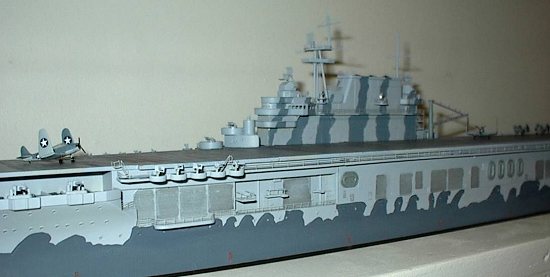
-pri-fly overhang on the port side of the island.
-SC radar
-main and aft yardarms- very nicely done by GMM!
-the rear tri-level platform with ladders- a tricky and delicate piece but worth it
-and railings on all levels as illustrated.
The island was set aside until paint time.
It was then on to the hull. Platforms and sponsons were added in order as per the instructions. I would say fit was good around the hull but would caution builders to test fit everything! I know I am guilty of not doing this basic step all the time. I guess it is a habit developed by the trust I have in Tamiya kits! While the Trumpeter instructions are laid out well, in some areas it is best to look 2 or 3 pieces ahead and test fit how the parts will fit against each otheróif one bulkhead or sponson is off- it may cause problems later on.
The various catwalks and gun tubs were added without trouble. I left off all the 20mm guns until later as well as the 5 inchers. I also added railing all around the ship at this time before painting. I am a lazy masker and knew I would have headaches painting the deck blue by hand later on but - thatís how I do it.
|
CAMOUFLAGE & MARKINGS |
When the hull was complete minus the flight deck- it was time for the base coat. Hornetís modified scheme did not change much during her wartime career. Colors were a base of Ocean Grey on hull and island. Navy Blue pattern on the hull and a Haze Grey pattern on the island. Flight deck was a Norfolk Stain 250-N but was almost the same as Navy Blue. Horizontal decks were deck blue 20-B. I used the new line of Testorís (ex-Floquil?) Marine Acrylic paints which offer direct matches for all the colors I needed. No mixing! Ocean grey was thinned with water and airbrushed on the entire hull, island and the PE fret. It airbrushed very nicely.
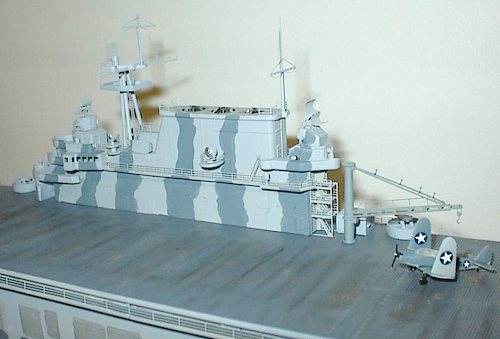 After a day of drying- it was on to the Navy Blue hull
pattern. Trumpeter provides a full color sheet with port and starboard
views- a nice touch. I thought about cutting a mask and airbrushing but
decided I would more than likely cause more damage to the hull that way. So I
laid the pattern out and brush painted the Navy Blue thinned slightly with
water. Results were good. When dry- I lightly sanded with the finest paper
I had to smooth out some brush strokes and to make the color uneven. Flight
deck parts were then glued on to the hull. Fit was OK here to but I needed a
lot of weight on the deck during bondingÖhow do I do this without damaging the
PE rails? Well, if you have them, 20 loaded M1 Garand en-bloc clips did a
fine job!
After a day of drying- it was on to the Navy Blue hull
pattern. Trumpeter provides a full color sheet with port and starboard
views- a nice touch. I thought about cutting a mask and airbrushing but
decided I would more than likely cause more damage to the hull that way. So I
laid the pattern out and brush painted the Navy Blue thinned slightly with
water. Results were good. When dry- I lightly sanded with the finest paper
I had to smooth out some brush strokes and to make the color uneven. Flight
deck parts were then glued on to the hull. Fit was OK here to but I needed a
lot of weight on the deck during bondingÖhow do I do this without damaging the
PE rails? Well, if you have them, 20 loaded M1 Garand en-bloc clips did a
fine job!
The island stripes did not look right with Testorís Haze Grey- it was more of a blue-grey so I used Intermediate Blue instead. Looks right to me.
DECK SEAMS:
The three deck pieces mated up pretty good. Of course there were 2 seams to fill and I used the non-sanding method with white putty. This uses Q-tips and nail polish remover to smooth out the putty. I think it works very well and this is the best tip I have learned in a while. When dry- I touched up the seams with more Navy blue. The Testorís paints brush quite well too.
|
FINAL CONSTRUCTION |
The island was attached- again- check fit here. I had to sand down a little for a good fit on one corner. Remaining bits were added like the 5-inch mounts, whale boats, and the tedious task of attaching PE gun shields to the 20mm singlesóthe GMM set also includes sights and elevation wheels but I was fried by this point and left them as is. These guns seem a little too big- some tall sailors are needed to man these guns! Touch up paint was added all around.
I also used GMM 1/350 deck figures to populate the ship in certain areas.
DECK WEATHERING:
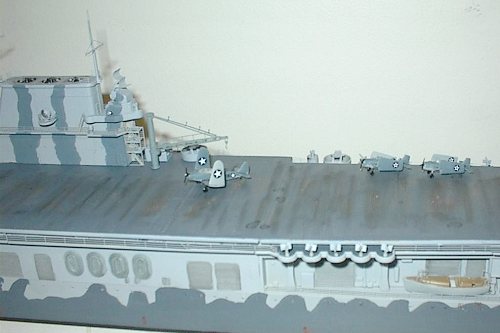 I looked at lots of color pics of WWII carrier decks to
see how best to weather my deck. Pics show a significant amount of natural
wood showing up where the stain had been worn off as well as oil stains, etc.
To replicate this, I used a dark tan color and an old brush to dry brush
across the deck mostly in the landing area portion of the deck. I also used
black/grey pastel chalk smudging across all sections of the deck. Finally,
for the oil stains I used my trusty mix of acrylic black mixed with water and
dish washing liquid to make little puddle stains and streaks.
I looked at lots of color pics of WWII carrier decks to
see how best to weather my deck. Pics show a significant amount of natural
wood showing up where the stain had been worn off as well as oil stains, etc.
To replicate this, I used a dark tan color and an old brush to dry brush
across the deck mostly in the landing area portion of the deck. I also used
black/grey pastel chalk smudging across all sections of the deck. Finally,
for the oil stains I used my trusty mix of acrylic black mixed with water and
dish washing liquid to make little puddle stains and streaks.
THE AIRWIING:
The aircraft took as long as the ship to build! Each aircraft consists of 2 hull halves, both horizontal stabilizers, wings (in some cases 4 pieces for folds), landing and tail gear, and canopies. Then painting and decals. Each plane took about 30 minutes to completeÖ
Hornetís airwing at the Midway battle consisted of TBD Devastators, SDB Dauntlesses, and F4F Wildcats. I wanted to represent each to some degree but the kit itself only comes with 2 each of B-25ís, SBDís, TBDís, and F4fís. This causes you to buy their sets of 10 aircraft to populate your deck. I sincerely hope Trumpeter decides to include more aircraft in the Essex kit.
I used the 2 TBDís that came in the kit as well as a handful of SBDís and F4Fís- some with wings folded and some without in preparation for operations. Light Grey and Intermediate Blue used for paint.
I placed them on the deck using some pics for reference.
|
CONCLUSIONS |
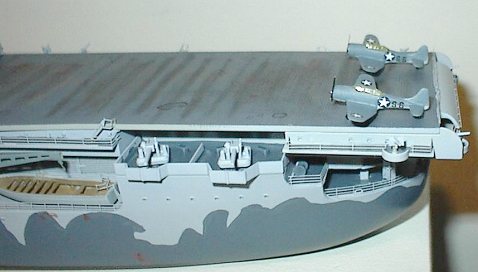 This was a great build and I am proud of the way the
model looks. Looking forward to the Essex. Fit was good but test fitting is
essential. There were no difficulties in construction so I think anyone with
a few ships under their belt could handle it. The GMM brass set was as usual
excellent. A few brass assemblies were a little delicate so experience with
PE brass is needed before using the set. If you can, it certainly adds a lot
to the finished kit especially the aircraft cranes, radar, railings, and boat
details. If you can get past the bow/ hull shape distortions- this is a fine
kit a promising sign of things to come from Trumpeter in their ambitious ship
release schedule.
This was a great build and I am proud of the way the
model looks. Looking forward to the Essex. Fit was good but test fitting is
essential. There were no difficulties in construction so I think anyone with
a few ships under their belt could handle it. The GMM brass set was as usual
excellent. A few brass assemblies were a little delicate so experience with
PE brass is needed before using the set. If you can, it certainly adds a lot
to the finished kit especially the aircraft cranes, radar, railings, and boat
details. If you can get past the bow/ hull shape distortions- this is a fine
kit a promising sign of things to come from Trumpeter in their ambitious ship
release schedule.
|
REFERENCES |
April 2003
If you would like your product reviewed fairly and quickly, please contact me or see other details in the Note to Contributors.